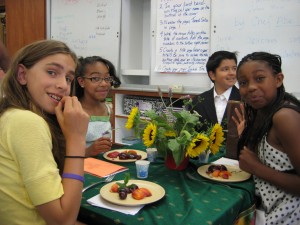Rethinking Lunchtime: Making Lunch an Integral Part of Education

Originally appears in the Winter 2008-2009 issue
As recently as two years ago, lunchtime at John Muir Elementary School in Berkeley, California, was not very different from school lunch periods across much of North America. The food was nondescript, greasy and calorie heavy, often delivered in pre-processed, heat-and-serve “units” shipped from thousands of miles away in wrappings bearing corporate logos. For students, lunch was a detour on the way to their real noontime goal: the playground.
Muir fifth-grade teacher Stephen Rutherford recalls that “children were claiming to be done with their lunch in five minutes and were leaving a huge amount of food waste, bag lunches uneaten, and school lunches just tossed, because their only mindset was to get out on the playground and have fun.” The school had no system for waste management, Rutherford notes, so children would “pour their waste into this or that bin in an atmosphere of chaos and neglect.”
Despite rushing through lunch, children were often left with as little as five or ten minutes to play (of the total 35 minutes allocated for lunch and recess), because so much time was lost as aides attempted to calm the children, establish order and get them to the playground. For both teachers and students, lunchtime meant a break not only from the school day but also from each other. One Muir teacher described the noisy, rowdy lunchroom as “Just not the place where you wanted to be.” As in many other schools, tussling and shoving in the lunchroom often carried over into bullying on the playground and sometimes into classes afterward.
This content is restricted to subscribers only.
If you are not yet a subscriber, please consider taking out a subscription here.
If you are an existing subscriber, kindly log in or contact us at info@greenteacher.com for more information.





